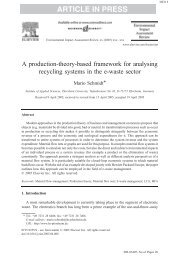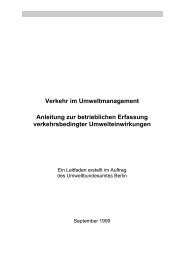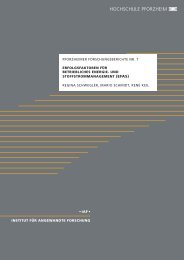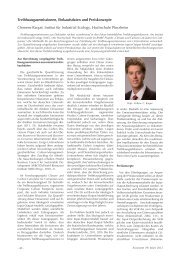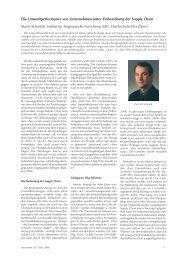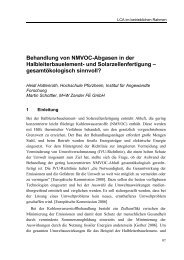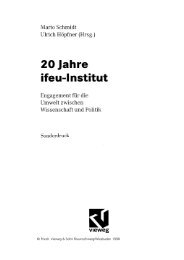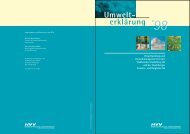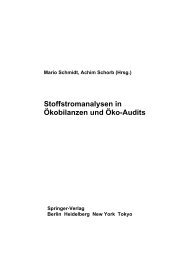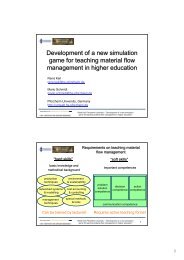Life Cycle Assessment of PET (Polyethylene Terephthalate) bottles ...
Life Cycle Assessment of PET (Polyethylene Terephthalate) bottles ...
Life Cycle Assessment of PET (Polyethylene Terephthalate) bottles ...
Create successful ePaper yourself
Turn your PDF publications into a flip-book with our unique Google optimized e-Paper software.
direction <strong>of</strong> improved process management<br />
such as are currently technically<br />
possible and appear feasible on the market<br />
- lead to changes in the two impact indicators,<br />
ranging from a few percent to<br />
about 10 percent. Changes in the system<br />
parameters have an essentially greater influence.<br />
Other assumptions regarding the<br />
credit for secondary materials or the recycling<br />
quotas can influence the results by<br />
several 10 percent, and generally even<br />
worsen them (= increase <strong>of</strong> values). These<br />
sensitivities are to be assessed individually,<br />
i.e. their contribution to results is always<br />
only based on the relevant measure;<br />
the contributions cannot be added. If the<br />
interaction <strong>of</strong> several measures is to be<br />
considered, overall scenarios must be calculated.<br />
Finally, in the sensitivity calculations<br />
several assumptions were changed at the<br />
same time and such overall scenarios<br />
were calculated. In accordance with the<br />
objective specified for this examination, attempts<br />
were made to set up an optimised<br />
scenario for the <strong>PET</strong> material recycling<br />
system. For this a reduced bottle weight,<br />
optimised <strong>PET</strong> bottle production, optimised<br />
filling, filling without rinsing and optimised<br />
<strong>PET</strong> recycling were assumed. This<br />
scenario can be considered as a scenario<br />
using the best technologies currently<br />
available on the market and the current<br />
possible improvement (e.g. bottle weight).<br />
The technologies can be realised today or<br />
are already in operation. By comparison<br />
with this, assumptions which would be<br />
speculative at the present time were omitted.<br />
These include in particular improved<br />
recycling quotas for <strong>PET</strong>.<br />
The optimising leads to a clear improvement<br />
<strong>of</strong> the <strong>PET</strong> material recycling<br />
system considered (Table 6). By comparison<br />
with the glass system the <strong>PET</strong> system<br />
now comes <strong>of</strong>f as set out below.<br />
The optimised material recycling system<br />
only comes <strong>of</strong>f worse than the glass<br />
returnable system for the impact indicators<br />
POCP and acidification potential. Otherwise<br />
it can be considered as equivalent or<br />
even better than the glass returnable system.<br />
However, this does not represent a<br />
final overall assessment, since the ecological<br />
relevance <strong>of</strong> the impact indicators<br />
in relation to each other has not been considered<br />
in this study.<br />
If one wish to be on the safe side, irrespective<br />
<strong>of</strong> ranking or weighting <strong>of</strong> the impact<br />
categories, and to produce ecological<br />
equivalence on the <strong>PET</strong> material recycling<br />
systems and the 0.7 l glass returnable system,<br />
the acidification potential has to be<br />
reduced further by about 1/3 <strong>of</strong> the value<br />
(starting from the already optimised system).<br />
The POCP value has to be reduced<br />
by as much as 2/3. The relevant influence<br />
parameter is the process <strong>of</strong> <strong>PET</strong> production<br />
here. With its hydrocarbon emissions<br />
it contributes chiefly to the POCP value. In<br />
the case <strong>of</strong> acidification potential, <strong>PET</strong><br />
production accounts for at least 35 %<br />
(net). In addition, the process <strong>of</strong> bottle<br />
production with 30 % is also relevant here.<br />
These two processes would have to be<br />
improved considerably in order to achieve<br />
ecological equivalence in these categories.<br />
The ecological equivalence would then<br />
only be effected by comparison with the<br />
0.7 l glass returnable bottle - which is still<br />
dominant on the market and generally<br />
considered to be environmentally sound.<br />
The <strong>PET</strong> returnable systems would then<br />
still have clear advantages over the <strong>PET</strong><br />
material recycling system.<br />
5. Conclusions<br />
An essential assumption in the packaging<br />
systems presented is that the <strong>PET</strong> material<br />
recycling systems are operated with a<br />
high share <strong>of</strong> high-grade recycled <strong>PET</strong> in a<br />
closed loop. Although initial experience in<br />
practice on an international basis is available<br />
here, an important question focuses<br />
on the technical and legal feasibility presumed<br />
for this LCA. It was assumed that<br />
50 % recycled <strong>PET</strong> is used in bottle production.<br />
This assumption appears to be altogether<br />
plausible, and technically even<br />
conservative. However, it is not conclusive<br />
for a real system. If the assumption does<br />
not materialise, the results change to the<br />
detriment <strong>of</strong> <strong>PET</strong> material recycling systems.<br />
On the other hand, the contributions <strong>of</strong><br />
<strong>PET</strong> production could be reduced further if<br />
recycled <strong>PET</strong> were used in a quasi closed<br />
loop system to a greater extent, in other<br />
words if recycled <strong>PET</strong> were used for bottle<br />
production again. A further increase <strong>of</strong> the<br />
assumed 50 % would come out clearly in<br />
12



